On View
Artist Jennifer Angus Wants You to See the Beauty of Bugs
The artist's solo show at the Bruce Museum features 5,000 recycled insect bodies.
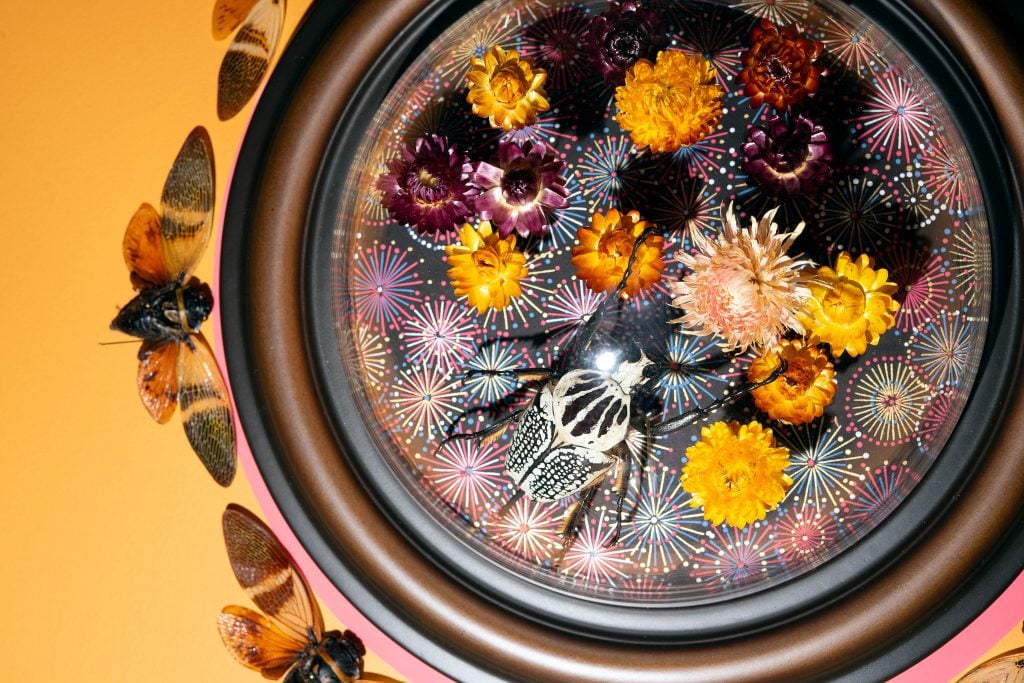
The artist's solo show at the Bruce Museum features 5,000 recycled insect bodies.

Adam Schrader

Jennifer Angus uses her bare fingers to delicately remove a pin holding down the thorax of a large, green insect affixed to a foam board she had used to transport its body. She must be careful: the specimen has been used so many times that holes have appeared in its form. After removing the pin, she hammers the body to the gallery wall to begin forming a pattern.
“It’s about the negative space between the bodies” Angus said as she worked to install her new solo show at the Bruce Museum in Greenwich, Connecticut. The show, “Jennifer Angus: The Golden Hour,” (on view through September 8, 2024) reuses the bodies of around 5,000 bugs to comment on an impending human-made global catastrophe.
The show begins with an Alice in Wonderland-esque experience in which Angus plays with scale. She has made small model homes that are elevated on platforms and form a sort of “main street” leading to a small church. The intent is to make the viewers feel insect sized.
Along the walls are small display boxes, dioramas in which Angus has personified some of her insects. In the same room, she has placed some of her damaged specimens in jelly jars to create a kaleidoscopic stained-glass window. The orange walls and glow of the “stained glass” give the room a feeling of sunset, mirroring the name of the show.
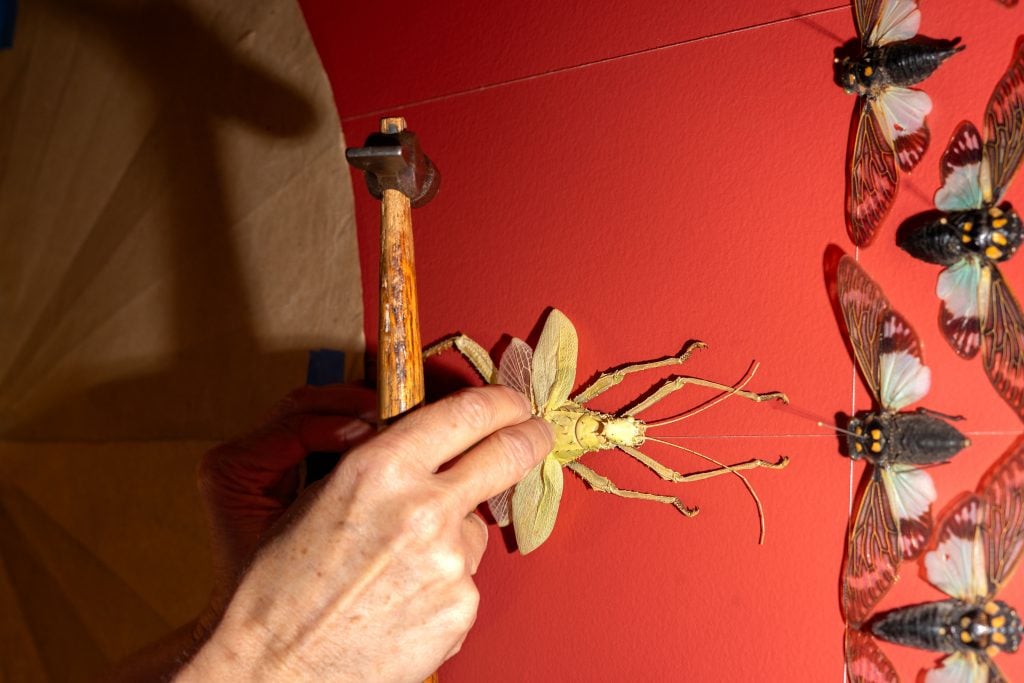
Jennifer Angus holds an insect specimen that she prepares to nail to a wall at the Bruce Museum in Connecticut as part of an art installation. Photo by Adam Schrader
The titular “golden hour” references the warm glow of light that illuminates the sky as the last rays of sunlight begin to fade, Angus said in a statement. She proposes that human life is in its golden hour and draws comparisons to the Doomsday Clock, a symbol for the likelihood of a human-made global catastrophe caused by things like nuclear war or climate change.
“We are in the twilight of the world as we know it,” she said in a statement. “‘The Golden Hour’ is intended to highlight what we stand to lose if action is not taken to prevent climate change, preserve natural habitats, quell the use of insecticides and overall see nature as something to be protected as opposed to a commodity to be used.”
In the next room is Angus’s cabinet of curiosities, where the artist has removed drawers from an antique to create more dioramas using her bug specimens. In some, she mixed the fallen-off parts of different bug species to create characters like the Cicada Lady, who has a cicada head, a beeswax body, and grasshopper arms.
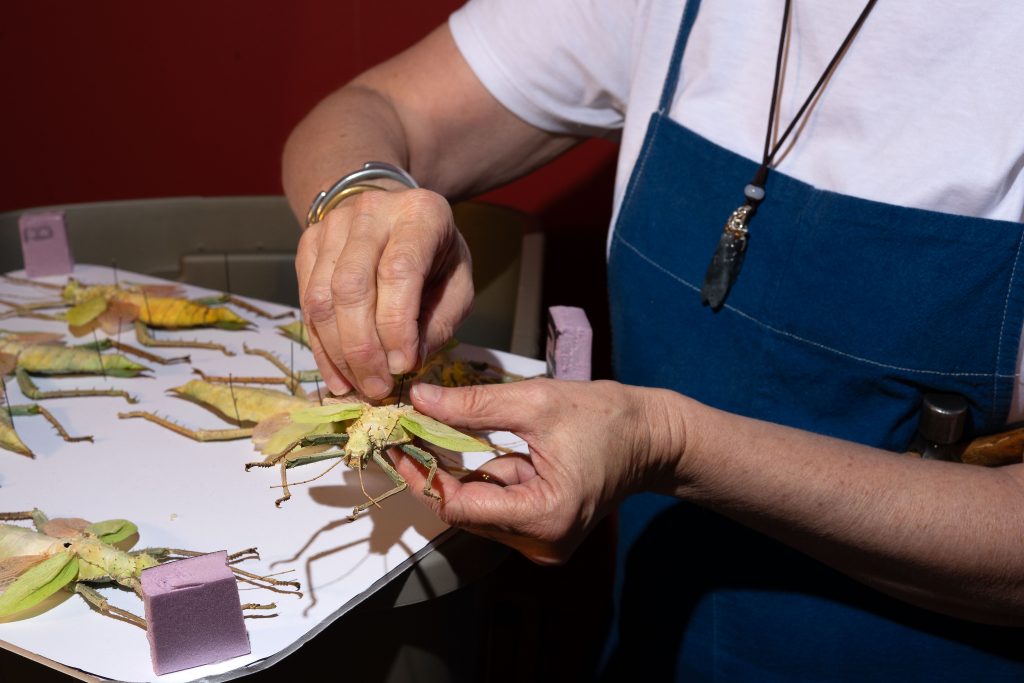
A closeup shows the artist Jennifer Angus removing a pin from a bug she transported to be used in an exhibit at the Bruce Museum. Photo by Adam Schrader.
“She’s sort of a teacher, which I think is a reflection of me,” she said. The artist was inspired to anthropomorphize the bugs because of Beatrix Potter’s The Tale Of Two Bad Mice, in which she made these mice look “cute.”
During the installation, this room also included what Angus called her “bug hospital”—complete with an emergency room and an outpatient clinic. Specimens that suffered damage during transport or installation are taken there to be glued back together.
“We’ve trained the registrar here how to fix them. She’s now a certified bug surgeon,” Angus said. “We repair them if we have the pieces and we put the not-so-great specimens high up or low down and keep the best ones at eye level.”
The show does not contain informational text, Angus said, because she is “not a fan of didactic work.” But she said she hopes the message of her work is clear, or at the very least, that people go to her website and find out more information about the world of bugs.
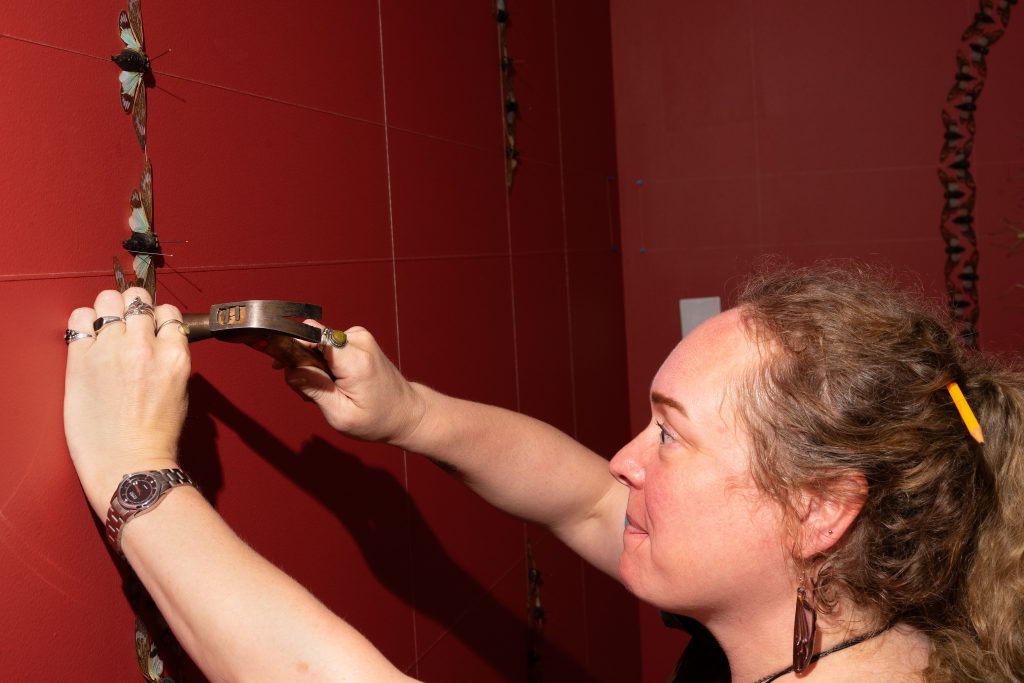
Lou Adams, a printmaker and former assistant to the artist Jennifer Adams, helps the latter install her artwork using bugs at the Bruce Museum in Connecticut. Photo by Adam Schrader
“Really, my hope is that anyone who comes to see the show will think about insects differently and not be so quick, most important of all, to get out that can of Raid,” she said.
Angus began working with bugs because she teaches textile design at the University of Wisconsin, Madison. About 20 years ago, she was researching textiles in northern Thailand and came upon a garment that was embellished with green metallic beetle wings.
“It makes total sense because these are mother nature’s sequins. They’re shiny, metallic green,” Angus said. So, she learned more about how bugs had been used by different cultures over time. For example, in the Victorian era, beetle wing embroidery used bug parts for high fashion. And in Southeast Asia, some cultures used them in headdresses.
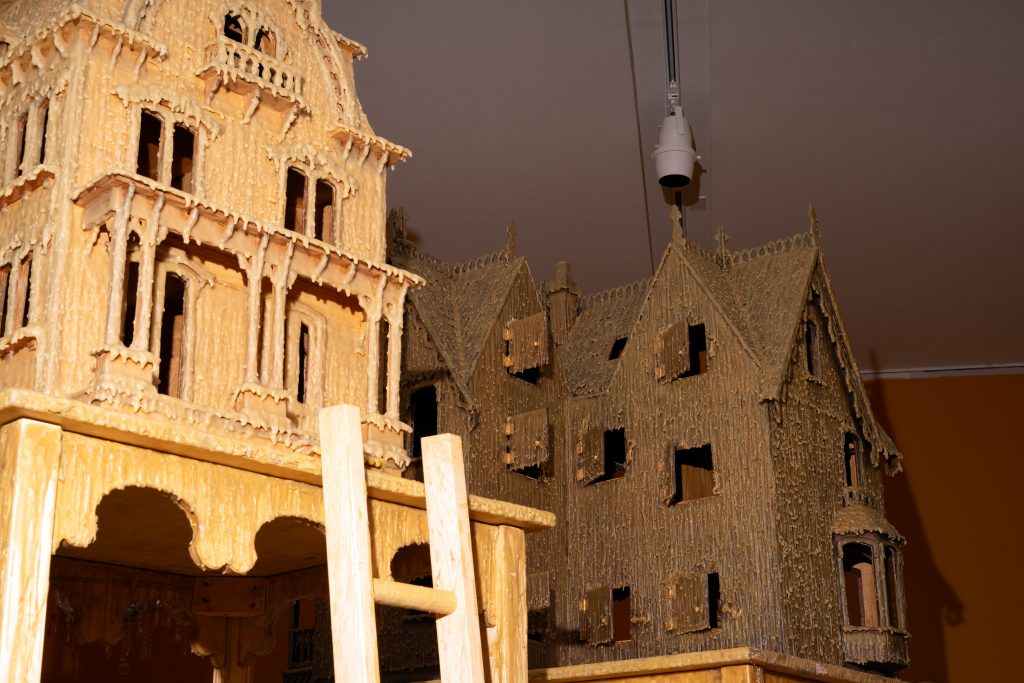
Model houses, including one that once housed crickets, is pictured in an installation by the artist Jennifer Angus at the Bruce Museum in Connecticut. Photo by Adam Schrader
One day, she decided to try her hand at using bugs to make patterns, which she said “felt really reckless” at the time. But the reaction she got from viewers of her first exhibit of such work affirmed her newfound medium.
“From a distance, the insects are flattened, and it looks like wallpaper and so people would walk up and then I’d literally see them take a step back as they realized what it was,” Angus said. “We see wallpaper as a domestic space. Yet that thing we don’t want inside is insects.”
Angus was surprised by the affordability of insect specimens. At the time, each bug cost her about 25 cents—even if they were somewhat difficult to purchase from insect specimen dealers used by academic institutions and museums. The most expensive insects in the exhibit are gold beetles from Costa Rica that can cost over $100 a pop.
“The internet was just starting so you would get a big book with all the species in black and white, no pictures. I had to learn what was right for my type of work,” she said. They have since become more expensive to buy but easier to obtain online.
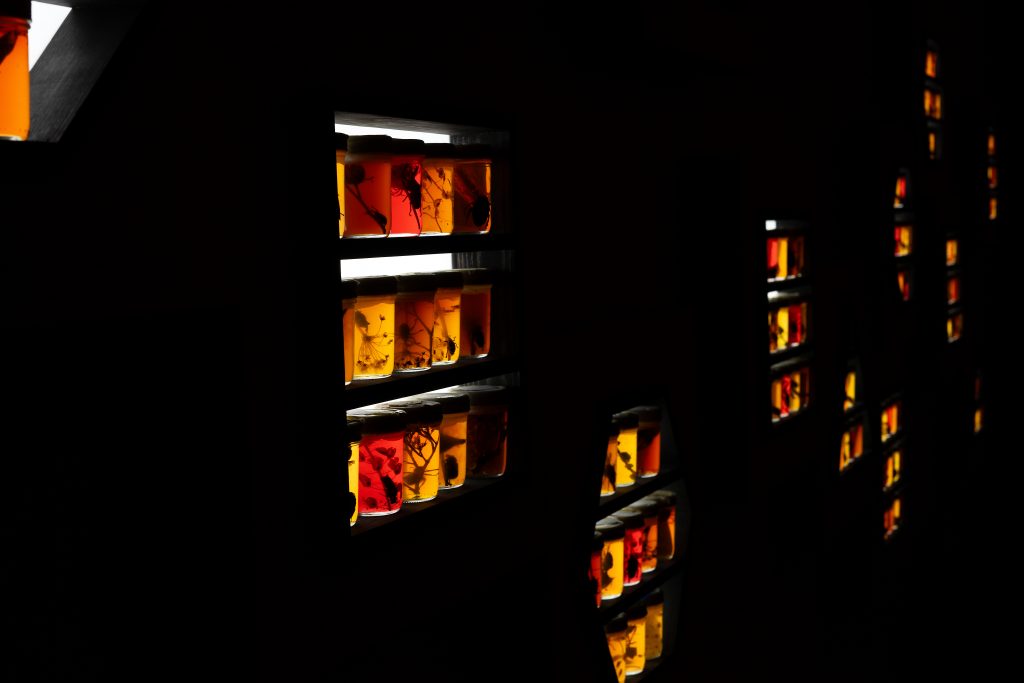
Damaged bugs that cannot be repaired or reused in Jennifer Angus’s artworks are preserved in jellies she makes and includes in an installation mimicking stained glass effect. Photo by Adam Schrader
It was fortuitous Angus chose the first specimen she did, the Eupholus schoenherrii—a type of blue weevil. She selected them for their pattern but realized quickly their bodies could withstand wear-and-tear. Cicadas also do well for her purposes, but butterflies and moths do not, she learned. And she never works with rare or endangered species.
“People go, ‘how many insects died for this exhibition?’ and I tell them that, first of all, these are reused,” Angus said. “What you’re seeing has gradually accumulated over more than 20 years. And if you’re upset, wonderful. That’s fantastic. Do something. Most of the species I used come from a tropical rainforest. We all know how fast the Amazon is being cut down.”
Even Angus was a little squeamish when she opened her first shipment of bugs and over the years there have been some species too gross to work with. But now, she admits she can eat dinner beside her bugs while working.
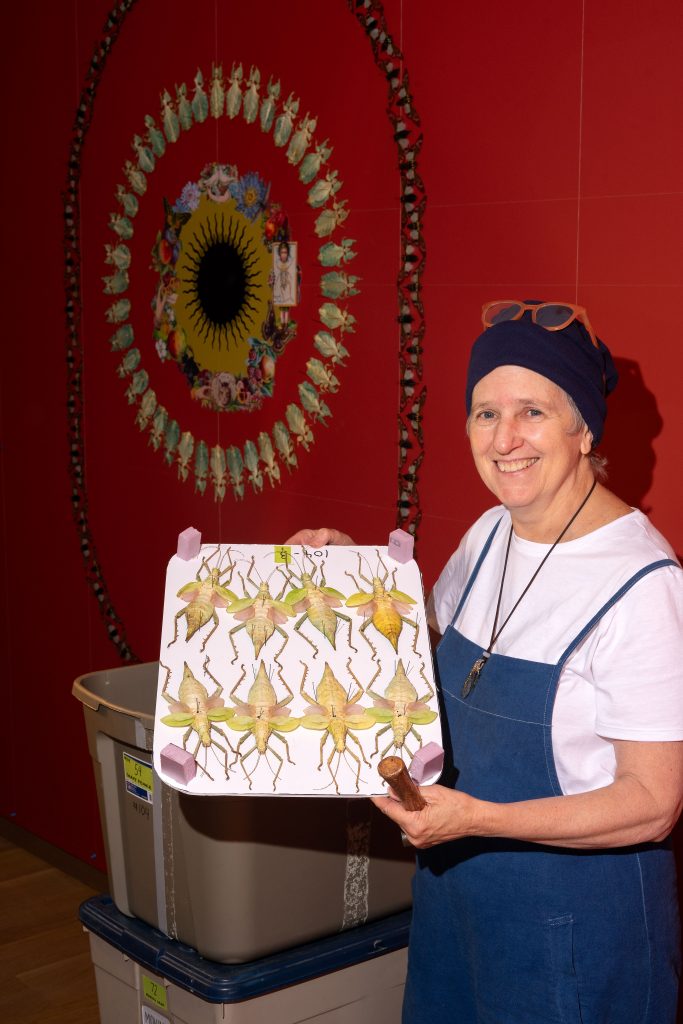
The artist Jennifer Angus is pictured holding bugs as transported to be used in a show of her work. Angus uses insects to create geometric patterns and other art, Photo by Adam Schrader
“I frequently say to the people that are upset, ‘These are adult specimens because if they weren’t, they’d be larvae. And it’d be a totally different show,’” she said. “There are going to be people who aren’t going to like this, I remember an e-mail that I got, and the subject line was ‘insecticide.’ I thought, ‘that’s quite clever.’”
Angus and her critics often end up agreeing that they want to see the insects thrive, even if their means to that end are different. But sometimes she also thinks about insects that conservationists don’t want to flourish, like invasive lanternfly species.
While Angus has had her fair share of critics, entomologists and the science community have supported her artistic endeavors. She recalled an exhibition at the University of Nebraska where the chair of the entomology department thanked her for making entomologists “look sexy.”
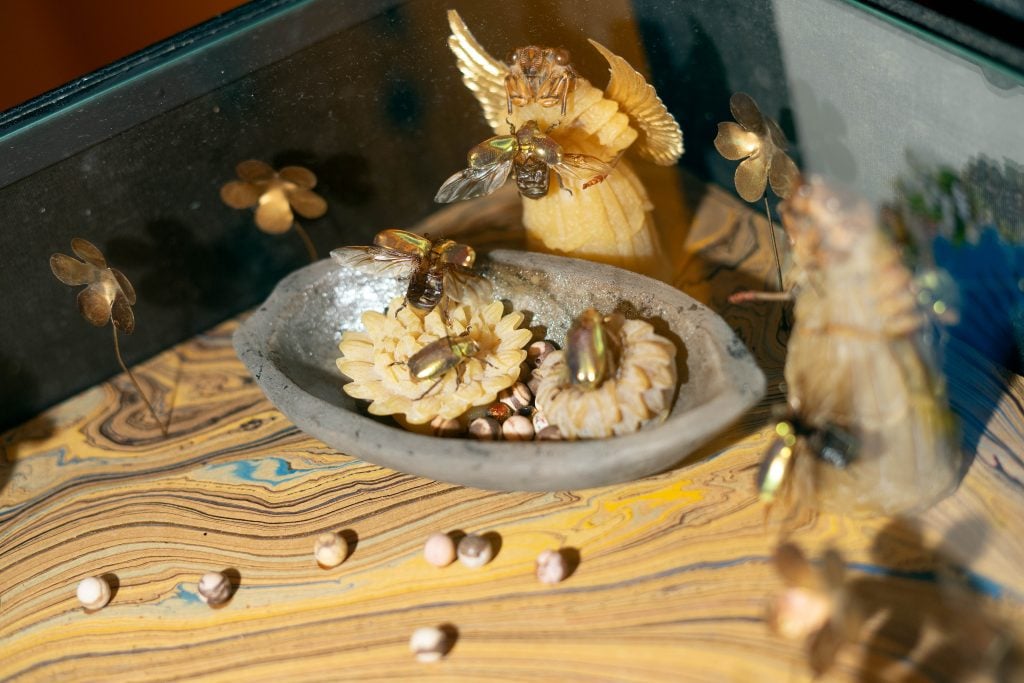
A valuable beetle known as Chrysina aurigans, native to Costa Rica, is pictured in an artwork by Jennifer Angus at the Bruce Museum in Connecticut. Photo by Adam Schrader
When asked if she had ever considered using live bugs in her work, Angus revealed that she had once used live crickets. Returning to the houses on “main street,” the artist said the very first one had its windows and doors covered with plastic film to keep live crickets in.
“I was reading about cricket cages, which are popular in China in summer because they have a beautiful song. In Germany there was a similar tradition, but it was a much more elaborate house. So that’s where I got this idea,” she said. “But what I have found after the first showing is curators really hate having to look after the livestock.”
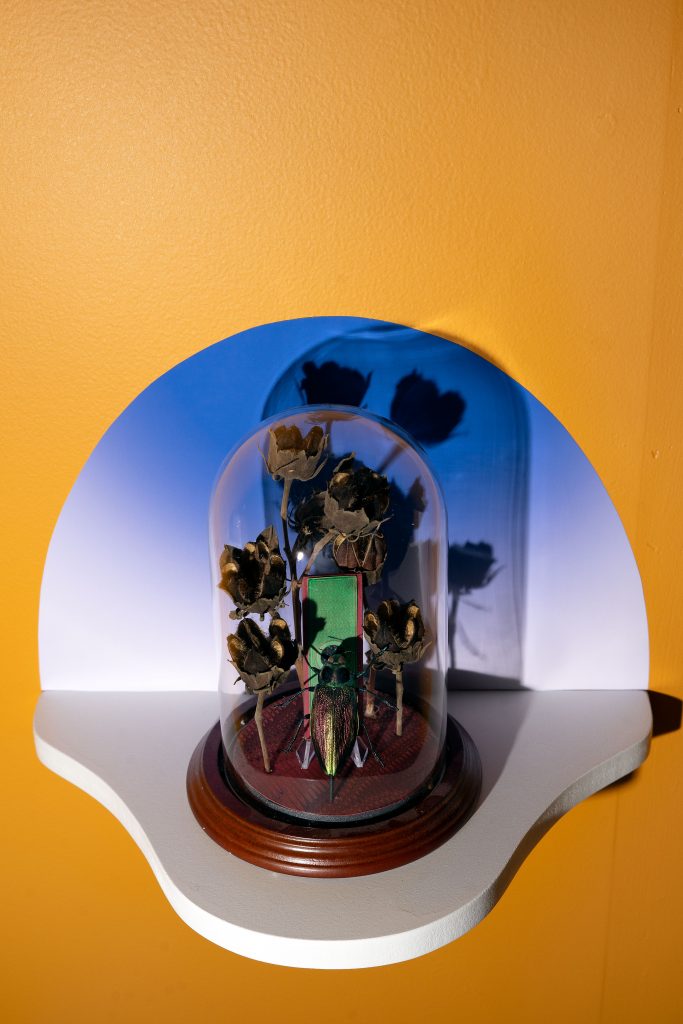
Photo by Adam Schrader.
Angus noted that the number of artists working with insects is relatively small and so they all sort of know each other.
“Like Catherine Chalmers, she’s the cockroach lady,” Angus said. “Jan Fabre, a Belgian artist, covered the royal palace with beautiful elytra. It’s inspiring, yet it’s horrific.”